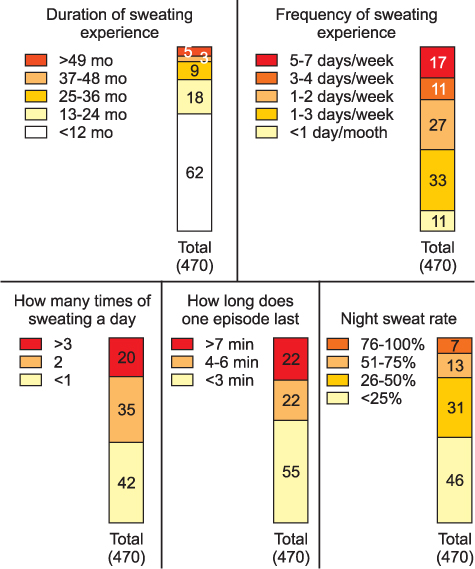J Korean Soc Menopause.
2012 Dec;18(3):147-154.
Epidemiologic Survey of Menopausal and Vasomotor Symptoms in Korean Women
- Affiliations
-
- 1Department of Obstetrics and Gynecology, Korea University Anam Hospital, Korea University College of Medicine, Seoul, Korea. tkim@kumc.or.kr
- 2Department of Obstetrics and Gynecology, Sungkyunkwan University School of Medicine, Seoul, Korea.
- 3Department of Obstetrics and Gynecology, Inha University College of Medicine, Incheon, Korea.
- 4Department of Obstetrics and Gynecology, Chung-Ang University Hospital, Chung-Ang University College of Medicine, Seoul, Korea.
Abstract
OBJECTIVES
Vasomotor symptoms (VMS) are one of the most annoying symptoms experienced by postmenopausal women. Generally, 75% of women over 50 years of age experience VMS. This study is an epidemiologic survey of menopausal symptoms and VMS in Korean menopausal women.
METHODS
Survey participants were recruited from Korean provinces based on the Korean population study conducted in 2010 and using multi-level stratification by age and geographic location, and random sampling. Healthy perimenopausal and menopausal Korean women aged between 40 to 60 years and who participated in the interview survey were included in the study. The Korean version of the Menopause Rating Scale (MRS) and the Korean version of Women's Health Questionnaire (WHQ) was used to investigate the prevalence of menopausal related symptoms and to assess quality of life.
RESULTS
Among the 1,500 women, 66% were classified as perimenopause, 28% as menopause, and 7% had undergone hysterectomy. Typically, 41.6% of women in perimenopause reported having experienced VMS in recent six months. About 53.1% of women in early menopause and 36.5% of women in late menopause had experienced VMS in the past six months. Whereas, 30.6% of women with hot flashes, and 27.9% of women with sweating stated that these symptoms were not related to menopause.
CONCLUSION
The prevalence of VMS in Korean women seems to be less than women of Western countries. Overall subjective experience of menopause was perceived as increasingly positive with age. Awareness of menopausal symptoms appeared lower than expected. Perimenopausal and menopausal women in Korea rarely sought medical care.
Keyword
MeSH Terms
Figure
Reference
-
1. Yang SJ, Kim JM. Diagnosis and treatment of menopause-related depressio. Korean J Biol Psychiatry. 2009. 16:229–237.2. Soules MR, Sherman S, Parrott E, Rebar R, Santoro N, Utian W, et al. Executive summary: Stages of Reproductive Aging Workshop (STRAW). Fertil Steril. 2001. 76:874–878.3. Kim H, Choi YM. Non-hormonal management of vasomotor symptoms. J Korean Soc Menopause. 2007. 13:157–163.4. Umland EM. Treatment strategies for reducing the burden of menopause-associated vasomotor symptoms. J Manag Care Pharm. 2008. 14:14–19.5. The Korean Society of Menopause. Management of menopausal women. 2007. 3rd ed. Seoul: Koonja.6. Choi H, Lee HK, Park HM. The Korean menopausal women`s attitudes and awareness on menopause: results of Korean gallup epidemiologic survey on menopause and HRT. J Korean Soc Menopause. 2003. 9:36–43.7. Utian WH. Psychosocial and socioeconomic burden of vasomotor symptoms in menopause: a comprehensive review. Health Qual Life Outcomes. 2005. 3:47.8. Spector RE. Cultural diversity in health and illness. 2000. 5th ed. New Jersey: Prentice Hall.9. Haines CJ, Xing SM, Park KH, Holinka CF, Ausmanas MK. Prevalence of menopausal symptoms in different ethnic groups of Asian women and responsiveness to therapy with three doses of conjugated estrogens/medroxyprogesterone acetate: the Pan-Asia Menopause (PAM) study. Maturitas. 2005. 52:264–276.10. Schneider HP, Heinemann LA, Rosemeier HP, Potthoff P, Behre HM. The Menopause Rating Scale (MRS): reliability of scores of menopausal complaints. Climacteric. 2000. 3:59–64.11. Heinemann LA, Potthoff P, Schneider HP. International versions of the Menopause Rating Scale (MRS). Health Qual Life Outcomes. 2003. 1:28.12. Hunter M. The Women's Health Questionnaire (WHQ): the development, standardization and application of a measure of mid-aged women's emotional and physical health. Qual Life Res. 2000. 9:733–738.13. Melby MK, Lock M, Kaufert P. Culture and symptom reporting at menopause. Hum Reprod Update. 2005. 11:495–512.14. Loh FH. Menopause and the Asian women: is she different from women of other ethnicities? Sex Reprod Menopause. 2007. 15:S6–S10.15. Im EO. Ethnic differences in symptoms experienced during the menopausal transition. Health Care Women Int. 2009. 30:339–355.16. Gold EB, Block G, Crawford S, Lachance L, FitzGerald G, Miracle H, et al. Lifestyle and demographic factors in relation to vasomotor symptoms: baseline results from the Study of Women's Health Across the Nation. Am J Epidemiol. 2004. 159:1189–1199.17. Lee MS, Yum SY, Hong JP, Yoon SC, Noh JS, Lee KH, et al. Association between painful physical symptoms and clinical outcomes in Korean patients with major depressive disorder: a three-month observational study. Psychiatry Investig. 2009. 6:255–263.
- Full Text Links
- Actions
-
Cited
- CITED
-
- Close
- Share
- Similar articles
-
- Menopausal Symptoms and Quality of Life according to Hormone Replacement Therapy in Rural Postmenopausal Women
- Association between vasomotor symptoms and sarcopenia assessed by L3 skeletal muscle index among Korean menopausal women
- Vasomotor Symptoms: More Than Temporary Menopausal Symptoms
- Updated treatment guideline for hormone therapy in postmenopausal women
- Associations between Vasomotor Symptoms and Depression, Stress and Quality of Life in Midlife Women





